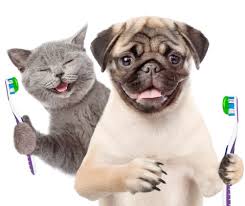Did you know that February is National Pet Dental Health Month? So, to celebrate, we wanted to share some information about the importance of daily teeth cleaning, and steps on how to begin if this routine is new for you and your pet.

Dental Health Information
For starters, let’s discuss dental prophylaxis. Dental prophylaxis, the fancy term for professional dental cleaning, is used to remove dental plaque and other irritants from the teeth. As the plaque deposits build on your pets teeth, they form dental tartar, which contributes to the majority of dental problems that occur.
Removing dental plaque daily seems to be the key to an excellent oral hygiene program. If your pet’s teeth are not brushed frequently, plaque will eventually build up at the gum line. Consequently, over time, calculus forms, gums become more irritated, and then infection can progress to loosen and destroy the tooth’s attachment. Besides having to extract teeth, infections under the gum line could also spread to the liver, kidneys, and heart.
Periodontal Disease
Periodontal disease is an infection caused by build-up of soft dental plaque on the surfaces of the teeth around the gums. The bacteria found in dental plaque irritate the soft gum tissue when plaque is allowed to accumulate, and often leads to infection in the bone surrounding the teeth.
In the beginning stages of the disease, cleaning above and below the gum line as well as removal of calculus (e.g. hard dental tartar) attached to the tooth will help restore periodontal health. Calculus consists of calcium salts from saliva deposited on top of the plaque. Tartar starts to form within a few days on a tooth surface that is not kept clean, and provides a rough surface that amplifies further plaque accumulation. Once the plaque has begun to grow in thickness, tartar becomes even more difficult to remove without dental instruments.
In advanced cases of the disease, either dental surgery or tooth extractions are performed. Additionally, antibiotics may be given monthly to help control the progression of periodontal disease.
Clearly, the best way to manage gum disease is to prevent it from beginning in the first place. When the surfaces of the teeth are cleaned frequently, the gums will, in turn, stay healthy. Excellent oral health is maintained by daily oral hygiene. Daily chewing activities can also be effective in maintaining oral health.
Studies have shown that the gold standard is brushing. You can begin your pet’s dental routine as soon as puppy or kitten teeth emerge. However, even though those tiny little baby teeth will be replaced with adult teeth, your puppy or kitten will get used to the brushing routine, which you can then continue for life.
What are the Consequences?
The most common tip-off for owners when identifying periodontal disease is that they note is their pet’s bad breath. However, this may only be the beginning. Many times gums become irritated, leading to bleeding and oral pain, and your cat or dog may lose its appetite or drop food from its mouth while eating. The roots of the tooth (or teeth) may become so badly affected that they may become loose and fall out. Bacteria surrounding the roots gain access to the blood stream (“bacteremia”).
Surprisingly, when it comes to canines, smaller breed dogs are more prone to having dental issues than larger breeds. Teeth are closer together in small dogs, and they usually live longer. As a result, Terriers, Maltese, and Shih Tzus are especially prone to periodontal disease.
The amount of time between teeth cleaning procedures depends on how often you are brushing your pet’s teeth. Cleaning their teeth once or twice a day is optimal. However, if you are unable to brush your pet’s teeth, then your pet will probably need two or three teeth cleaning visits per year performed by your veterinarian.
Four Steps to Get You Started
For starters, here are four steps to take to begin a good oral hygiene program for your pets:
- Watch How to Introduce Your Pets to the Accept Teeth Brushing – in this YouTube video, Dr. Sheldon Rubin gives easy, step-by-step instructions on how to teach a dog or cat to accept daily tooth brushing. He also describes healthy treats, and explains the true risks of periodontal disease in pets.
- Purchase a Pet Toothbrush and Toothpaste – Choose a soft-bristled toothbrush with handle, or finger toothbrush. Next, purchase toothpaste from your veterinarian, Amazon, or local pet store, that is specifically geared towards animals. Do not use human toothpaste because it has detergents that should not be swallowed, and could make your pet sick.
- Invest in Dental Wipes – If your pet has an aversion to a pet toothbrush, look into purchasing Dental Wipes instead, as they can also be very effective in removing plaque. Be sure to wipe the area where the tooth meets the gumline.
- Contact your Veterinarian to Schedule a Dental Cleaning – Once you notice plaque or tartar accumulation (a yellow or brown material at the area where the tooth meets the gumline, especially over the cheek teeth and canines), it’s time for a professional cleaning. Do not wait.
Additional Resources
For additional tools in the marketplace to keep your pet’s teeth in tip top shape, please visit the VOHC website for lists of approved products for dogs and cats. The Veterinary Oral Health Council (VOHC) is a non-profit organization composed of board certified veterinary dentists that reviews studies and accepts dental products that have been shown to reduce the accumulation of plaque and/or tartar. VOHC exists to recognize products that meet pre-set standards of plaque and calculus (tartar) retardation in dogs and cats. Products are awarded the VOHC Seal of Acceptance following review of data from trials conducted according to VOHC protocols.




Leave a Reply